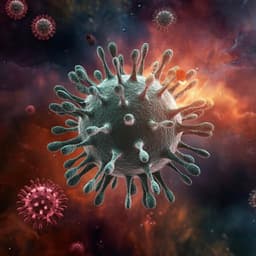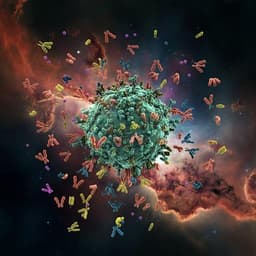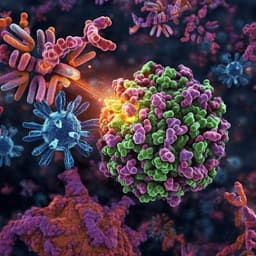
Biology
Protective roles and protective mechanisms of neutralizing antibodies against SARS-CoV-2 infection and their potential clinical implications
E. C. Abebe and T. A. Dejenie
This remarkable review by Endeshaw Chekol Abebe and Tadesse Asmamaw Dejenie delves into the protective roles of neutralizing antibodies against SARS-CoV-2. It uncovers how these antibodies prevent infections and reinfections, their clinical implications, and explores exciting therapeutic potentials amidst challenges such as variant emergence.
~3 min • Beginner • English
Introduction
The review addresses how neutralizing antibodies (NAbs) contribute to protection against SARS-CoV-2 infection and disease, delineates their mechanisms of action, and discusses clinical implications for diagnostics, prognosis, therapy, and vaccination. It contrasts neutralizing versus non-neutralizing antibodies, highlights the centrality of humoral immunity, and frames key challenges such as adverse events linked to antibody-based interventions and immune evasion by emerging variants. The purpose is to synthesize current knowledge to inform the development of potent vaccines and antibody-based therapies against COVID-19.
Literature Review
The article synthesizes evidence that NAbs are strong correlates of protection against primary infection and reinfection, drawing on human studies, animal models, and vaccine trials. It reviews antibody isotypes (IgG, IgA, IgM), noting IgG1/IgG3 dominance and the substantial contribution of IgA, including mucosal sIgA. Kinetics data indicate early appearance (within 1–2 weeks) and variable durability with gradual waning over months, though IgG can persist up to a year in many individuals. Evidence from convalescent plasma transfer and monoclonal antibodies in animals and humans supports the protective role of NAbs. Vaccine studies (mRNA-1273, BNT162b2, ChAdOx1, Ad26.COV2.S, NVX-CoV2373, inactivated vaccines) demonstrate robust NAb induction and Th1-skewed responses, with neutralization levels correlating with observed vaccine efficacy. The review compiles correlates-of-protection analyses linking standardized neutralization titers to clinical protection. It also surveys diagnostic serology platforms (anti-N vs anti-S/RBD), virus neutralization tests (PRNT) and their limitations, and FDA EUA-approved assays. Clinical studies associating antibody levels, neutralization titers, and a neutralization potency index with disease severity and survival are summarized. Finally, it compiles challenges including ADE risk, Th2/eosinophilic immunopathology, waning immunity, and variant-mediated immune escape, with proposed mitigations (RBD-focused immunogens, Th1-promoting adjuvants, booster doses, and reformulated vaccines to elicit broadly neutralizing antibodies).
Methodology
This is a narrative literature review. The authors compile and synthesize findings from peer-reviewed studies, clinical trials (e.g., COVE, ENSEMBLE, PREVENT-19, COV002/COV006), observational cohorts, animal challenge models, in vitro neutralization studies, FDA guidance and EUA documentation, and meta-analyses. No formal systematic search strategy, inclusion/exclusion criteria, or quantitative meta-analysis methods are described. Instead, the review integrates diverse evidence streams to summarize the roles, mechanisms, and clinical implications of NAbs in COVID-19.
Key Findings
- Neutralizing antibodies are key correlates of protection against SARS-CoV-2. Higher neutralization titers predict reduced risk of infection, disease, and reinfection; passive transfer studies in animals confirm causality.
- Isotypes and subclasses: IgG is the main systemic correlate; IgG1 and IgG3 dominate, with IgG3 displaying up to ~50-fold higher neutralizing potency than other subclasses. Neutralizing IgA, including secretory IgA, contributes to mucosal protection and can neutralize comparably to IgG.
- Kinetics: NAbs detectable ~7–15 days after symptom onset; IgM appears by day ~4, peaks in week 1, wanes by ~20–30 days; IgG rises within 1–2 weeks, peaks ~day 16–50, then declines but can persist for many months (often up to a year); IgA peaks ~day 15–30 and wanes by ~45–50 days. Neutralization activity declines over 1.3–6.2 months in many reports, with substantial interindividual variability.
- Protection from reinfection: Prior infection/vaccination confers substantial protection (e.g., ~89% protection among seropositives), dependent on NAb quality and quantity. Protection wanes over months, especially in older or immunocompromised persons.
- Mechanisms of action: Primary neutralization via Fab-mediated binding to spike RBD blocks ACE2 interaction; NAbs may also target non-RBD epitopes or interfere with alternative/coreceptors (e.g., TMPRSS2, NRP1, GRP78, DPP4, AXL, CD147, lectins, vimentin), and can inhibit conformational changes/membrane fusion. When infection occurs, Fc-mediated effector functions (ADCC, ADCP, CDC) aid clearance of infected cells.
- Antigenic targets: Anti-spike, especially anti-RBD, antibodies correlate with neutralization; anti-nucleocapsid antibodies are abundant but typically non-neutralizing and less persistent.
- Diagnostics and immune monitoring: Anti-S/RBD assays better reflect neutralization than anti-N assays. PRNT/cVNT is the gold standard but is low-throughput; surrogate/automated assays (e.g., Roche Elecsys anti-S, Abbott AdviseDx, EUROIMMUN S1, cPass sVNT, DiaSorin TrimericS) show high sensitivity/specificity and are useful for surveillance and correlates-of-protection assessments.
- Prognostic markers: Higher antibody and neutralization titers often associate with more severe disease, but the neutralization potency index (quality relative to quantity) better predicts outcomes; index ≥100 predicted 100% 30-day survival versus 87% when <100 in one study.
- Therapeutics: Convalescent plasma with high NAb titers may benefit early disease and immunocompromised patients; overall RCT evidence is mixed with minimal benefit in many settings. Monoclonal antibodies (e.g., bebtelovimab, tixagevimab/cilgavimab, bamlanivimab/etesevimab, casirivimab/imdevimab, sotrovimab) showed efficacy pre-Omicron but many lost activity against Omicron, limiting use. Multimeric isotypes (IgM/IgA mAbs) may offer higher neutralization efficiency than IgG with identical Fab.
- Vaccines and correlates of protection: Multiple platforms (mRNA, viral vector, protein subunit, inactivated) elicit NAbs and Th1-skewed responses. Early efficacy reported: mRNA-1273 and BNT162b2 >95%; ChAdOx1 ~79%; Ad26.COV2.S ~66–77%; NVX-CoV2373 ~90%; BBIBP-CorV ~79.3%. Neutralization correlates with efficacy: mRNA-1273 day 57 ID50 of 10, 100, 1000 IU50/mL correspond to estimated efficacies of ~78%, 91%, 96%; Ad26.COV2.S D29 ID50 <2.7 IU50/mL ~60%, rising to ~78% at 9.9 IU50/mL and ~89% at 96.3 IU50/mL; NVX-CoV2373 ID50 of 50, 100, 1000, 7230 IU50/mL correspond to ~75.7%, 81.7%, 92.8%, 96.8% efficacy; ChAdOx1 nCoV-19 ~80% efficacy associated with anti-S 264 BAU/mL, anti-RBD 506 BAU/mL, pseudovirus NAb ~26 IU/mL (≈185 ID50), and live-virus neutralization NF50 ~247. Antibody waning necessitates boosters; boosters restore neutralization and improve protection against variants (notably Omicron), though infection protection remains short-lived.
- Challenges and safety: Potential antibody-dependent enhancement (ADE) and Th2/eosinophilic immunopathology are concerns for plasma, mAbs, and some vaccine strategies, though many studies do not observe enhanced respiratory disease. Variant immune escape (e.g., mutations N501Y, E484K, K417N/T; Omicron lineage) reduces neutralization and effectiveness for vaccines and mAbs. Mitigations include selecting antigens that focus responses on neutralizing epitopes (e.g., RBD), Th1-biasing adjuvants, reformulating vaccines to include diverse spike sequences to elicit broadly neutralizing antibodies, and timely booster dosing.
Discussion
The compiled evidence demonstrates that neutralizing antibodies are central to protection against SARS-CoV-2, mechanistically preventing entry and facilitating clearance of infected cells, and clinically serving as correlates of protection and potential prognostic biomarkers. These insights directly inform vaccine design—optimizing for strong, durable NAb responses and Th1 polarization—and therapeutic strategies, such as early use of high-titer convalescent plasma in select patients and development of mAbs resilient to viral evolution. Diagnostic serology centered on anti-S/RBD and functional neutralization assays can guide assessments of individual and population immunity, donor selection, and vaccine evaluation. At the same time, risks such as ADE, Th2-skewed pathology, waning immunity, and variant immune escape emphasize the need for vigilant monitoring, rational antigen/adjuvant choices, booster strategies, and next-generation vaccines that elicit broadly neutralizing activity. Overall, the review consolidates a framework for leveraging NAbs in clinical and public health responses to COVID-19 while highlighting areas requiring continued adaptation as the virus evolves.
Conclusion
Neutralizing antibodies targeting the SARS-CoV-2 spike, especially the RBD, are indispensable for preventing infection by blocking receptor engagement and membrane fusion and for assisting clearance via Fc-dependent effector functions. They serve vital roles across clinical domains: augmenting diagnostic strategies, quantifying and tracking protective immunity, indicating disease severity and prognosis, informing therapy (plasma, mAbs), and underpinning vaccine efficacy as the primary correlate of protection. However, potential adverse immune phenomena (ADE, Th2/eosinophilic responses), waning antibody levels, and variant-driven immune escape complicate antibody-based prophylaxis and treatment. Future efforts should focus on designing vaccines that elicit durable, broadly neutralizing responses across variants (e.g., multivalent or updated spike sequences, RBD-focused immunogens with Th1-promoting adjuvants), optimizing booster strategies, and developing next-generation mAbs (including multimeric isotypes) with breadth and potency against circulating and emerging variants.
Limitations
- The review is narrative without a specified systematic search protocol, risking selection bias and incomplete coverage.
- Heterogeneity across studies (assay platforms, endpoints, timing, populations) limits direct comparability of antibody titers and correlates.
- Durability of protection and precise protective thresholds vary by assay and variant; generalizability across variants (especially Omicron sublineages) is uncertain.
- Evidence on convalescent plasma efficacy is mixed, with benefits context-dependent (e.g., timing, titer, patient immune status).
- ADE and Th2/eosinophilic risks remain incompletely defined in humans; findings are sometimes model-dependent and contradictory.
- Rapid viral evolution can outpace conclusions regarding vaccine and mAb effectiveness, necessitating ongoing updates.
Related Publications
Explore these studies to deepen your understanding of the subject.







